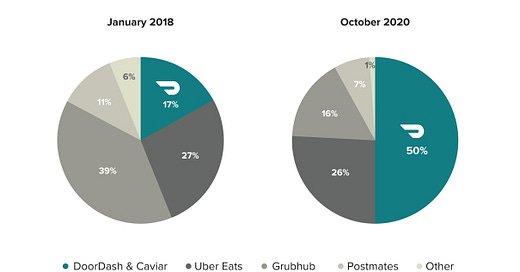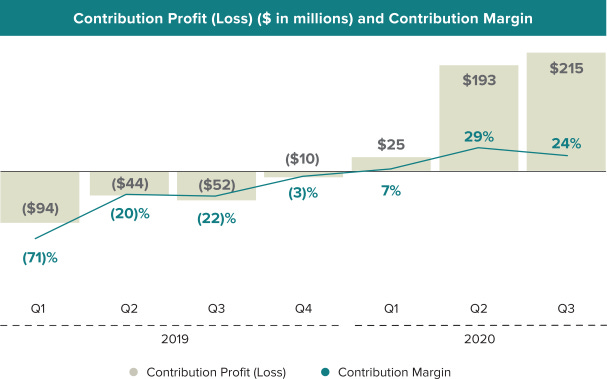Elite Overproduction; DoorDash #64
The Problem with The Mass-Production of Elites, Looking into DoorDash's S-1 Filing
Elite Overproduction
This is an interview from the Atlantic featuring Peter Turchin, someone who "has as been warning for a decade that a few key social and political trends portend an age of discord, civil unrest and carnage worse than most Americans have experienced. In 2010, he predicted that the unrest would get serious around 2020, and that it wouldn’t let up until those social and political trends reversed."
The center of his premise is around the idea of elite overproduction and supported by declining living standards among the general population and a government that can't cover its financial positions.
He defines “elite overproduction as the tendency of a society’s ruling classes to grow faster than the number of positions for their members to fill. One way for a ruling class to grow is biologically—think of Saudi Arabia, where princes and princesses are born faster than royal roles can be created for them. In the United States, elites overproduce themselves through economic and educational upward mobility: More and more people get rich, and more and more get educated. Neither of these sounds bad on its own. Don’t we want everyone to be rich and educated?
The problems begin when money and Harvard degrees become like royal titles in Saudi Arabia. If lots of people have them, but only some have real power, the ones who don’t have power eventually turn on the ones who do."
This creates a growing number of counter-elites for every elite position.
Take a look at protests around the world.
Revolts have happened in poor countries like Somalia and affluent countries like France, Chile, and the US – and the public in revolt, when looked at closely, consists mostly of the middle class and college-educated people. That’s true everywhere.
The cycle looks like this "Elite overproduction creates counter-elites, and counter-elites look for allies among the commoners. If commoners’ living standards slip—not relative to the elites, but relative to what they had before—they accept the overtures of the counter-elites and start oiling the axles of their tumbrels. Commoners’ lives grow worse, and the few who try to pull themselves onto the elite lifeboat are pushed back into the water by those already aboard. The final trigger of impending collapse, Turchin says, tends to be state insolvency."
This trend has been accentuated by social media - as explained in by Martin Gurri, the author of The Prophet of the Revolt.
"The elites had abandoned the idea of serving the public before the arrival of the digital tsunami. What that catastrophe did was to reverse the polarities of power: it was the public that was now technologically adept, politically restless, and in revolt against the perplexed elites. The vast gap remained, and the elites have no wish to cross it – to do so would mean breaking that wall that protects the pure soul of the Brahmin.
We have no way of knowing whether a more talented elite class could have avoided the current anger mobilizing the public or the hair-trigger impulse to revolt. There are no laboratories that run parallel versions of history. I will say this: the struggle today is structural, not personality-dependent. Even an FDR or a Reagan would have difficulty preserving institutions whose authority has collapsed because of a radical reversal in the information environment."
A couple of interesting takes by Martin and Peter:
The Case Against Credential-Oriented Education
He opposes credential-oriented higher education, for example, which he says is a way of mass-producing elites without also mass-producing elite jobs for them to occupy. Architects of such policies, he told me, are “creating surplus elites, and some become counter-elites.” A smarter approach would be to keep the elite numbers small, and the real wages of the general population on a constant rise. I largely agree - we are increasingly seeing a world where credential does not equal an elite job as one may have hoped. At an aggregate level, you're fostering an entire generation that resents the status quo.
Democracy is Aided by Conflict
The effect of war is to reward communities that organize themselves to fight and survive, and it tends to wipe out ones that are simple and small-scale. “No one wants to accept that we live in the societies we do”—rich, complex ones with universities and museums and philosophy and art—“because of an ugly thing like war,” he said. But the data are clear: Darwinian processes select for complex societies because they kill off simpler ones. Democratic societies flourish because they have a memory of being nearly obliterated by an external enemy. They avoided extinction only through collective action, and the memory of that collective action makes democratic politics easier to conduct in the present.
Writing History
“If you look at who is doing these megahistories, more often than not, it’s not actual historians,” Walter Scheidel, an actual historian at Stanford, told me. (Scheidel, whose books span millennia, takes Turchin’s work seriously and has even co-written a paper with him.) Instead, they come from scientific fields where these taboos do not dominate.
Radicalism Today
"When you organize online, you don’t need any of the trappings of 20th-century radicalism – a revolutionary command and control organization, a maximum leader, a program, even a coherent ideology. All you need is a smartphone and a sufficient measure of anger against. This carries tremendous tactical advantages. The street insurgents will invariably catch the authorities by surprise because institutionally they don’t exist. They are a crowd from the cloud: people from nowhere that suddenly materialize everywhere.
But the digital path to revolt suffers from a congenital, and probably fatal, strategic defect. Without a leader or a program, you can’t maneuver. You can’t adjust your tactics. You can’t negotiate with power, for example. Surprisingly often, governments have caved in and offered to meet the protesters’ demands; this happened in Israel in 2011 and France in 2019. In both cases – in every case I am aware of – the protesters showed little interest in figuring out what their demands were. They wouldn’t take yes for an answer."
Looking into DoorDash’s S-1
DoorDash is one of many tech IPOs slated to launch over the next few months/quarters. The team just released their S-1, a document designed to explain their business, financials, progress to date, and key risks for potential investors.
Their strategy is built around the following assets:
An on-demand logistics platform that can facilitate the local delivery of any item
Merchant services to grow sales in the modern era
A membership program to the physical world for consumers
I found the S-1 to be a fairly interesting read given the massive growth of the meal delivery market post-COVID-19. While the stats here are undoubtedly designed to present DoorDash favorably, here are some interesting tidbits.
DoorDash’s Strategy
They consider themselves to be a merchant-first business - solving key challenges such as "customer acquisition, delivery, insights and analytics, merchandising, payment processing, and customer support."
According to this graphic, DoorDash is a key leader in their category owning 50% of the market. Despite this growth, DoorDash consumers only represent 6% of U.S. consumers signaling a massive growth potential.
The inherent assumption here is how DoorDash defines its category of spend and how it compares to key competitors such as Uber Eats.
The flywheel below describes the focal points of DoorDash's strategy. It also explains why these companies spend a lot on new customer acquisition. A quick heuristic to see who will win this battle is by simply looking among your friend circle and checking to see if Uber Eats or DoorDash is likely to become a verb.
One risk that I wasn't highlighted as well as I thought it should have been in the growing cost to start and maintain this flywheel. With an oligopoly of platforms and an endless supply of 'special offers,' the startup and maintenance costs will inevitably grow. The marginal benefit of growing into new markets will shrink. In this case, I think DoorDash has done a better job than Uber in terms of managing the number of markets it grows into vs. re-investing in its core markets.
Economics of the Meal Delivery Model
For those who have wondered how much each party makes in a typical meal delivery, see the graphic below. I'd be curious to see what the average marketplace order looks like (not an illustrative one). My guess is that order sizes tend to be slightly smaller (with a much smaller tip) - making it difficult for any of the parties to earn the return illustrated below.
The illustration below leads me to believe that the market could be slightly smaller than the entire U.S. population. How many households can afford to 'waste' around 15-20% of their meal cost on convenience?
One opportunity for platforms could be to tackle the catering market. With most events being limited to less than 10 people, people end up doing multiple/large orders from a number of restaurants. I'm sure certain restaurants can offer family-sized offers on DoorDash and Uber eats and make it easier for people hosting COVID-friendly events.
COVID-19 Impact
The pandemic certainly accelerated the growth of DoorDash and its ability to reach profitability. I suspect it will be extremely difficult to maintain these margins as the need for meals delivered decreases (assuming a vaccine is launched and/or businesses adapt to the current circumstances).
The counter-argument to the point above is that we'll see more merchants that are designed for platforms like DoorDash/Uber Eats. This can be done by offering food/items at times where it might not be available (e.g. snacks/desserts at midnight).
Conclusion
Overall, I don’t see this as a business being investment-worthy. Although it is interesting to understand how the model works and why DoorDash and Uber Eats behave the way they do.
Stripe Press
Stripe Press is a treasure trove of books that I’d recommend reading.
Here are a few recommendations:
Get Together by Bailey Richardson, Kevin Huynh, Kai Elmer Sotto
The Revolt of the Public and the Crisis of Authority in the New Millennium by
Martin Gurri
Asking Questions During an Interview
This thread is a great resource for those looking to do customer or job interviews or even due diligence into a company.

Here are some of the questions I took away from this thread:
What's a feature request that you get a lot, but that you will never build?
What are the 2-3 key metrics that management looks at to drive the business?
If you had 1 bullet, which competitor would you shoot with it?
What indicators do you watch closely on a weekly/monthly basis?
Who's most difficult to replace and why?
Tell me about your favorite customers
What decisions can only you make and why?
What’s the most misunderstood thing about your company and industry?
Where do you go to listen to what your customers are saying?
When are your customers and/or employees wrong?
Thanks again for reading this week’s newsletter. If you can just comment on what you think is interesting, what you find confusing, and what you think is boring or irrelevant, that would be really helpful.
Until next week,
Suthen






